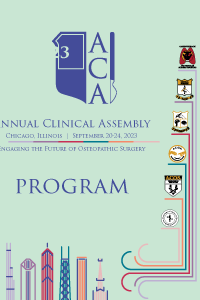General Surgery
An immunohistochemical anomaly: a case report and systematic review of myofibroblastoma of the breast
- BK
Poster Presenter(s)
Myofibroblastoma (MFB) is a rare, benign mesenchymal tumor most commonly found in the breast1-3. MFB can also occur in various extramammary locations, including the head, neck, popliteal fossa, groin, vulva and paratesticular region1. Though histopathologic analysis is very meticulous, it can still pose challenges to diagnosis of MFB as this lesion is histologically similar to many breast malignancies1. In this report, we describe the case of a 47-year-old female with MFB of the breast as well as conduct a review of documented cases of MFB in the literature and identify variance in patient presentation and immunohistochemical staining of biopsied lesions across documented cases of MFB.
Methods or Case Description:
Case report:
We share a case of a 47-year-old premenopausal female who presented for evaluation of a breast mass. She denied family history of breast cancer, abnormal mammograms, or abnormal breast biopsies in the past. The patient had recent ultrasound and mammogram imaging, as well as ultrasound-guided core needle biopsy, which was taken of the 1 cm lesion, 1 cm from the nipple at the 9 o'clock position, with tissue marker placement. Histopathology of the lesion showed immunohistochemistry (IHC) markers for pancytokeratin, desmin, and ER were negative, while CD34, vimentin, and smooth muscle actin were positive. These results were consistent with a spindle cell lesion suggestive of myofibroblastoma. Complete surgical excision was recommended due to these results, and the patient was referred to our office for this reason. She had SAVI SCOUT guided right breast lumpectomy completed with our office and noted resolution of symptoms.
Methods:
An electronic-based search using the database PubMed was conducted with the search subject “myofibroblastoma AND breast”. The search was limited to cases in humans and published in the English language with full text available, with no restriction based on year published. Our preliminary search yielded 779 articles, with exclusion criteria of non-English articles and non-case report articles. After excluding articles that were not accessible by the authors, 160 articles remained. These articles were manually reviewed and, after eliminating articles that were not pertinent, not case reports, or not accessible, 34 articles remained. Of note, four articles reported on multiple cases, yielding a grand total of 38 patient case reports analyzed.
Outcomes:
Most reported cases of MFB of the breast involve men and postmenopausal women5. Some cases, including ours, have involved MFB appearing in premenopausal women. While the patient presented in this case study had complained of pain associated with her breast lesion, most cases typically present as painless and are overall asymptomatic6. Physical exam of MFB usually reveals a solid, well-defined, mobile lesion without adherence to the dermis. Clinically, MFB shares many features with those of benign breast fibroadenoma which makes the differentiation between the two challenging and underlines the importance of core needle biopsy and histopathological evaluation to aid in the diagnosis of MFB. Immunohistochemistry seen in most cases of MFB reported in the literature are ER-positive; however, out of the 38 cases reviewed in our study, only one case documented a diagnosis of MFB with a negative ER seen on the IHC panel. 16 positive ER cases were documented, while the rest of the cases did not specify either the presence or absence of ER. While the presence of CD34 is often described in the literature as the defining IHC marker for MFB, we documented 7 cases that reported MFB with negative CD34 markers. All cases that documented staining for protein S-100 were negative, except for one. The median age of diagnosis of MFB was 59 years old. This finding supports the suggestions of MFB occurring more commonly in older males and post-menopausal females. The youngest age of diagnosis of MFB, however, was 17 years old, which demonstrates the possibility of MFB appearing in this age group.
Conclusion:
The purpose of this report is to describe the variance in immunohistochemistry amongst cases of myofibroblastoma of the breast and to describe a case of MFB in a premenopausal woman. This detailed case review of 38 MFB case reports portrays the challenges in diagnosing MFB of the breast, as a result of the variety in symptom presentation, age, gender, location, and immunohistochemical staining. This denotes the importance of proper work-up of this lesion, including proper immunohistochemical analysis to form a diagnosis, which can sometimes have pitfalls. Investigation into the recurrence, implications, complications, and malignant transformation of MFB remains an area of future exploration.

